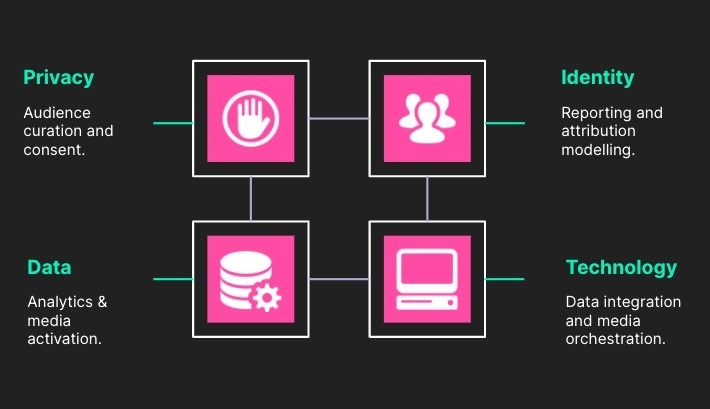Data privacy legislation and third party cookie deprecation are shaping the future of marketing. With 49% of industry professionals citing cookie deprecation as their top media challenge of 2021, it’s an issue that cannot be tackled by marketing alone.

Despite the many benefits that third party cookies have provided, it’s also worth noting their unreliability, with 64% of users reporting that they cleared cookies manually, which makes our recent reliance on cookies for everything from ad targeting to measurement seem a little flawed, on reflection.
Tearing ourselves away from third-party cookies is going to cause the most technical disruption, but it’s only part of the challenge. Add to this legislative changes such as GDPR, CCPA, and the persistent rollout of privacy-conscious identity blocking technology such as the phasing out of IDFA and Apple’s Mail Privacy protection – all of this will make managing and monitoring marketing impact much more difficult.
Don’t throw the baby out with the bathwater!
There is of course a viable option here to move away from the fabled precision of cookie based tracking and targeting and back toward old-school marketing methods. We could in theory rely on last-click attribution or campaign URL parameters as a perfectly acceptable (but imperfect) measurement solution. This would mean letting go of our preoccupation with measuring everything, and operate with a lot less data, and a lot more faith that good marketing will eventually carry the day.
It’s true that the fundamentals of marketing have not changed, but we still have the option of taking advantage of tools and technologies that allow us to continue to deliver campaigns that are more targeted, and more measurable than we had 20 years ago, and while I agree that strong creative is essential to cut through a saturated advertising landscape, relying on contextual targeting alone will not provide the kind of personalised experience that customers are looking for now and in the future.
How to Prepare Your Business for a Privacy-First Future
All good plans begin with an evaluation. How do you assess whether your business is ready for the cookieless, privacy-centric future? How much do you currently rely on third-party data for media activation and measurement? These are some of the questions you need to answer in order to prepare your organisation for changes that are already shaping the way we communicate with customers online.
To help shape your analysis, we believe there are four core competencies that will need realignment in order to be successful in the next few years, which you can see in the visualisation below.

Using privacy, data, identity and technology together will put you in a good place to adapt your operations based on the changes we’re encountering right now.
Arguably the most immediate, short-term challenge for most businesses is going to be moving away from third-party data and cookie-based identifiers. Therefore your first step should be to analyse and understand the gap that currently exists in your use of third party data and what changes you’ll inevitably need to make once third-party cookies disappear entirely in 2023.
Data Challenges
Before we dive into any more detail let’s take a moment to explain what we mean by first, second and third-party data, and some of the challenges related to each type of data.

- First-party (known data) – this is the gold standard for marketing data in that it is collected and owned by brands. Opted-in newsletter subscribers are an example of first-party data that can be collected by brands. This data is limited in scale vs. 2nd and 3rd party data but much richer and more valuable once collected.
- Second-party (walled-off) 2nd party – second-party data is essentially someone else’s first-party data. An example here is the data Facebook has on page likes/audience information from their platform that advertisers can use for targeting.
- Third-party (unconsented or unknown) – this data is offered by companies who are not the original collectors of that data. As an example, Google Ads offer brands access to third-party data in the form of their Google Display Network publisher data – which is data gathered by publishers on the GDN.
While third party data can enable brands to easily scale to reach new audiences, it’s not as reliable as first-party data and is seen as far less trustworthy by consumers when utilised for marketing communications.
Why First-Party Data is The New Marketing Gold
While privacy is obviously a key concern for customers, they still expect relevant information and personalised content where possible. Indeed, thanks to online pioneers, such as Amazon, customers have grown to expect and desire personalized experiences: a recent survey from Mckinsey found that the vast majority of US consumers (80 percent) expect personalisation from retailers.
Balancing privacy concerns with the need for relevant, personalised experiences is the challenge we all now face as marketers.
First-party data enables rich, personalised experiences and addressability through trusted 1:1 relationships with existing customers, while at the same time increasing the accuracy of machine learning and audience targeting features on major ad platforms through matched/similar audience expansion features.
Unlike second and third-party data, your first-party data is a unique asset to your business that is not easily accessed by your competitors.
The Value Exchange Economy
Hopefully, by this point, you’ve understood the importance of growing your own first-party data to offset the loss of third-party data, and continue to provide relevant messages to new and existing customers.
The key to building first-party data is a clear exchange of value for consumers in return for their data. This is proving a big challenge for many brands, with only 15%of consumers feeling they’re getting good value from granting access to their data.

To overcome this, brands need to be more clear and transparent about where the data goes and what you will do with it.
There are many ways you can provide value using consumer data, including:
- Convenience – Provide convenience in exchange for people’s contact information, such as sending a notification when an item is back in stock or updating them when their order status has changed.
- Relevant Information – Providing the right information to consumers based on their interests and behaviours is a simple yet effective way of delivering an exchange of value. Examples include curated email communications, industry updates and training (for B2B).
- Incentives – Offering a deal or coupon when people agree to provide their email address or phone number to receive your marketing communications.
- Exclusives – Invite people to register and sign into an account or loyalty program where they can receive exclusive content, personalised recommendations and reward credits.
For more information on value exchange check out my colleague Julie Reid’s recent post here.
Reviewing Your MarTech Stack
The platforms and technologies that you once relied upon for targeting and attribution will be hit hard by these changes. Specifically, programmatic advertising platforms who rely on publisher data for targeting and attribution will no longer be in a position to provide the granularity of data they once did using third-party cookies.
So what can you do to adapt? It’s time to take a step back and answer the following questions:
- What data do you need now and in the future?
- How is your data currently organised and collected?
- What do you intend to do with this data? Will it be used for email marketing, ad targeting, sales prospecting?
- Who owns and manages the platforms where marketing data is stored? How do they currently integrate with one another?
There are thousands of platforms out there claiming to be able to personalise and measure experiences better than others. The truth is that these platforms will only be as successful as the quality of the first-party data you are able to integrate into them.
The key is not the platforms themselves, it’s the data integration between them. This is why it’s important to read up on concepts such as data clean rooms, which have the potential to compare your own first-party data with advertiser data to enable a much better view of advertising performance.

If your data is spread across several decentralised sources – wrangling the data is your first challenge, and this is not something that happens overnight. This is something that involves building shared identifiers, using either a CRM tool, a customer data platform or building your own solution.
Creating a Privacy-First Transformation Plan
Hopefully, this post has given you some food for thought about how your business may need to adapt to the challenges posed by the privacy-based challenges we’re facing right now.
Here are a few steps to get you started on your transition to a privacy-first marketing approach:
- Understand how external changes will impact you – how will these changes impact the way you currently collect and curate customer data?
- Assess the current state and set realistic goals – how do you plan to use customer data in the future? How are you collecting customer data right now?
- Conduct a gap analysis – which areas do we need to invest in to meet your goals? Is there a technical gap and/or a skills gap?
- Prioritise and create a roadmap – prioritise your requirements based on the goals you set in point 2 and what’s required to take you to this desired future state
Targeting and measurement will no longer happen in the way we’re used to. Device-based attribution is being replaced by privacy-safe alternatives. Longing for the old days and looking for short-term workarounds won’t get you far. It’s time to prepare your business for the changes that are already upon us.
Looking for support? Look no further! Our marketing data audit is the first step in assessing your business readiness for a privacy-first future.
If you have any questions, don’t hesitate to get in touch with us.









